Missing from this review from the July 1975 Monthly Film Bulletin is any acknowledgment that Godard and Gorin’s rather punitive analysis against Jane Fonda’s role in a still photograph might have incidentally reflected some misogyny along with their resentment against the power of a movie star. For those interested in tracking down Letter to Jane, it’s included as an extra on the Criterion DVD of Tout va bien. —J.R.

Letter to Jane
France, 1972 Directors: Jean-Luc Godard, Jean-Pierre Gorin
Letter to Jane was initially made to be shown in a specific limited context: as a short accompanying Tout va bien at the New York and San Francisco Film Festivals in 1972. As with all of Godard and Gorin’s joint projects, the essential aims of the film are demystification and political analysis. More generally, it pursues a demystification of cinema itself as art object, reflected in the minimal technical means used in the articulation of the filmmakers’ argument (a montage of stills separated by cuts or makeshift wipes accompanied by the voices of Godard and Gorin in English, with brief uses of recorded music as punctuation) — an approach further developed by Godard’s more recent work with video, which seeks to demonstrate that the “production of sounds and images” need not be as expensive or as technically elaborate as is usually supposed. Read more
These are expanded Chicago Reader capsules written for a 2003 collection edited by Steven Jay Schneider. I contributed 72 of these in all; here are the third dozen, in alphabetical order. — J.R.
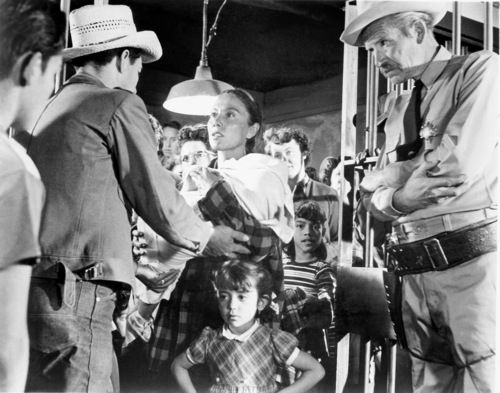
Salt of the Earth
This rarely screened 1954 classic is the only major American independent feature made by communists; a fictional story about the Mexican-American zinc miners in New Mexico then striking against their Anglo management, it was informed by feminist attitudes that are quite uncharacteristic of the period. The film was inspired by the blacklisting of director Herbert Biberman, screenwriter Michael Wilson (A Place in the Sun), producer and former screenwriter Paul Jarrico, and composer Sol Kaplan, among others; as Jarrico later reasoned, since they’d been drummed out of Hollywood for being subversives, they’d commit a “crime to fit the punishment” by making a subversive film. The results are leftist propaganda of a very high order, powerful and intelligent even when the film registers in spots as naive or dated. Basically kept out of American theaters until 1965, it was widely shown and honored in Europe, but it’s never received the recognition it deserves stateside. Regrettably, its best-known critical discussion in the U.S. is in Pauline Kael’s final essay in her first collection — a 1954 broadside in which this film is ridiculed as “propaganda” alongside a forgettable cold war thriller, Night People, that’s skewered as “advertising”. Read more
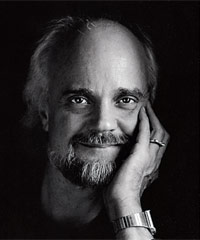
Born July 24, 1944, San Mareno, California. Died May 23, 2013, Chicago, Illinois.
Here’s something I said at a special tribute to Peter held in his presence at Columbia College, on October 4, 2012:
“For me, Peter Thompson is one of those special filmmakers who reinvents cinema for his own purposes, a trait that he shares not only with people like Robert Bresson, Carl Dreyer, and Jacques Tati, but also with filmmakers like Chaplin, Welles, and Kubrick.
“On some level, all of Peter’s films are mysteries and detective stories, but ones in which Peter is inviting us to join him in becoming the detectives, not in giving us puzzles that he knows how to solve but in inventing new ways for us to share in his curiosity. You might even say that part of the mysteries of his films is determining what they’re about, because in addition to reinventing cinema they might be said to reinvent things like subject matter and research as well as still more difficult-to-define entities such as poetry and history and truth.
“Peter has been a friend for about two decades, but I hasten to add that we became friends because of my enthusiasm for his early work, which existed before we ever met. Read more
From the Chicago Reader (August 27, 1993). — J.R.
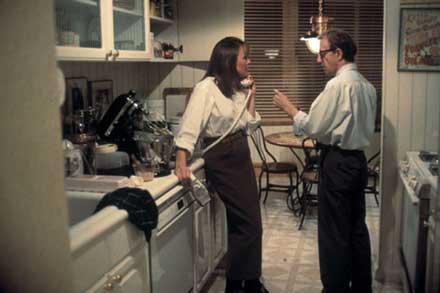
MANHATTAN MURDER MYSTERY
*** (A must-see)
Directed by Woody Allen
Written by Allen and Marshall Brickman
With Allen, Diane Keaton, Alan Alda, Anjelica Huston, Jerry Adler, Joy Behar, Ron Rifkin, and Lynn Cohen.

It’s instructive to divvy up Woody Allen’s movies into “art films” and entertainments. Without too much boiling and scraping, I think you could say that the entertainments come from his first 11 years as a filmmaker, from What’s Up, Tiger Lily? (1966, now missing from the press-kit filmography) to Annie Hall (1977), while his art-film efforts extend from Interiors (1978) to Husbands and Wives (1992).
Some would argue that Broadway Danny Rose (1984) and The Purple Rose of Cairo (1985), coming halfway through the second period, belong to the entertainment category, along with “Oedipus Wrecks” (1989), his contribution to New York Stories, but I would beg to differ. (The first of these is in black and white, the second traffics in misery and pathos, and the third derives directly from Fellini’s episode in Boccaccio ’70 — the first pieces of counterevidence I’d cite.) Similarly, to those who’d claim that the “foreign movie” sketch in Everything You Always Wanted to Know About Sex (But Were Afraid to Ask) (1972) pushes it into the art-movie category, I’d maintain that there’s a world of difference between this film’s parody of Antonioni and the pastiches of the later movies. Read more
From the Chicago Reader (July 13, 2001). — J.R.

A.I. Artificial Intelligence
Rating **** Masterpiece
Directed by Steven Spielberg
Written by Spielberg and Ian Watson
With Haley Joel Osment, Jude Law, Frances O’Connor, Brendan Gleeson, William Hurt, Jake Thomas, and the voices of Jack Angel, Ben Kingsley, Meryl Streep, Robin Williams, and Chris Rock.
If the best movies are often those that change the rules, Steven Spielberg’s sincere, cockeyed, serious, and sometimes masterful realization of Stanley Kubrick’s ambitious late project deserves to be a contender. All of Kubrick’s best films fall into one vexing category — they’re strange, semi-identified objects that we’re never quite prepared for. They’re also the precise opposite of Spielberg’s films, which ooze cozy familiarity before we’ve figured out what they are or what they’re doing to us. If A.I. Artificial Intelligence — a film whose split personality is apparent even in its two-part title — is as much a Kubrick movie as a Spielberg one, this is in large part because it defamiliarizes Spielberg, makes him strange. Yet it also defamiliarizes Kubrick, with equally ambiguous results — making his unfamiliarity familiar. Both filmmakers should be credited for the results — Kubrick for proposing that Spielberg direct the project and Spielberg for doing his utmost to respect Kubrick’s intentions while making it a profoundly personal work. Read more
Commissioned and published by New York’s Metrograph Chronicle in mid-December 2019. — J.R.
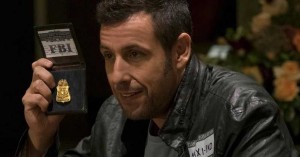
“Would you forgive me if I die?” — Question asked in the first scene of Heaven Knows What
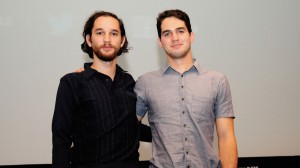
The movies of Josh and Benny Safdie are dominated by compulsively impulsive hustlers who continuously revise their own lives as well as those of everyone else in their immediate vicinities, most often with chaotically disastrous consequences for everyone concerned. Maybe because these scheming and prevaricating characters know how to tell lies and (somewhat less often) how to apologize for or cover up their various messes, they also qualify, at least some of the time, as skillful escape artists as well as stylish con men. They exasperate their colleagues, spouses, and other family members, who almost invariably wind up forgiving these crumb-bums for their lies and deceptions after hearing their shame-faced apologies, which are typically followed by further deceptions. This dizzying pattern seems to culminate in their new film Uncut Gems, which registers at times as a slapstick remake of Abel Ferrara’s Bad Lieutenant (1992) — at least if one can allow for a substitution of a certain amount of manic Jewish optimism for depressive Catholic despair. Read more
The following interview by Sara Donoso, printed in Spanish and English in Fotocinema no. 14 (2017), was conducted in Santiago de Compostela while I was serving on the jury of Curtocircuíto, the international festival of short films held there. I’ve taken the liberty of lightly revising Donoso’s English, and I’ve also retained her Spanish introduction.– J.R.
THE EXPANSION OF CRITICISM: AN INTERVIEW WITH JONATHAN ROSENBAUM
Sara Donoso
Universidad de Santiago de Compostela, España
saradonosocalvo@gmail.com

Crítico, ensayista y teórico de cine, la pluma de Jonathan Rosenbaum es de aquellas que practican el ejercicio de la resistencia; que se oponen a la clasificación, las etiquetas, al mundo del mainstream y a la cultura del espectáculo. Podríamos decir que es uno de esos críticos tal vez incómodos para algunos pero necesarios y reveladores para quienes aprecian el séptimo arte. Tras trabajar como principal crítico del Chicago Reader entre 1987 y 2008, actualmente sigue ejerciendo el ejercicio de la escritura cinematográfica a través de su página web, en la que no solo postea periódicamente reseñas de libros o películas sino que cuenta además con un archivo de publicaciones anteriores.
Como autor y editor, ha contribuido a través de diferentes proyectos a la difusión y dignificación del cine más allá de los circuitos comerciales, siendo responsable de títulos como Movie Mutations: The Changing Face of World Cinephilia (2003),Essential Cinema: On the Necessity of Film Canons (2004) o Goodbye Cinema, Hello Cinephilia: Film Culture in Transition (2010). Read more
This appeared in the August 21, 1998 issue of the Chicago Reader. –J.R.
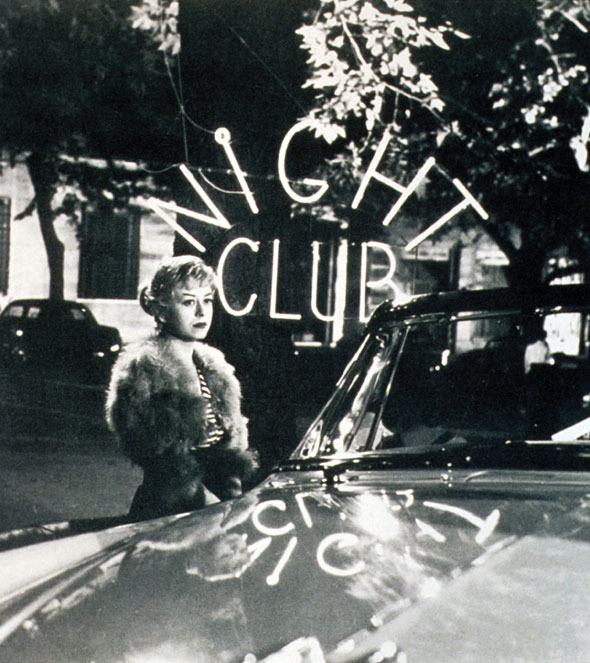
Nights of Cabiria
Rating **** Masterpiece
Directed by Federico Fellini
Written by Fellini, Ennio Flaiano, Tullio Pinelli, and Pier Paolo Pasolini
With Giulietta Masina, Franca Marzi, Francois Perier, Amedeo Nazzari, Dorian Gray, and Aldo Silvana.
By Jonathan Rosenbaum
Reporting on the response to Federico Fellini’s Nights of Cabiria at Cannes in 1957, François Truffaut wrote, “Let us deplore the fad that seems to be shared equally by the audience, producers, distributors, technicians, actors, and critics who fancy that they can contribute to the ‘creation’ of the films being shown by deciding how they should have been edited and cut. After each showing, I’d hear things like ‘Not bad, but they could have cut a half-hour,’ or ‘I could have saved that film with a pair of scissors.'” As festival responses to more recent masterpieces like Taste of Cherry and The Apostle have shown, this fad is still very much with us. Another, more recent fad is to release longer versions of films that were butchered on their release. Too often these so-called director’s cuts — such as Pat Garrett and Billy the Kid and the forthcoming Touch of Evil — can’t qualify as restorations, however, because the directors were never accorded final cut in the first place. Read more
This may be Antonioni’s most unjustly neglected fiction feature, at least in the U.S. (though even in France, where it’s on DVD, it’s only available in a box set). I reviewed it for the May 1975 issue of Monthly Film Bulletin. –J.R.
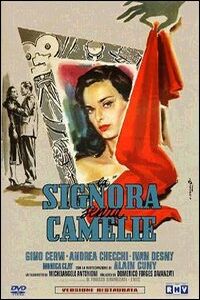
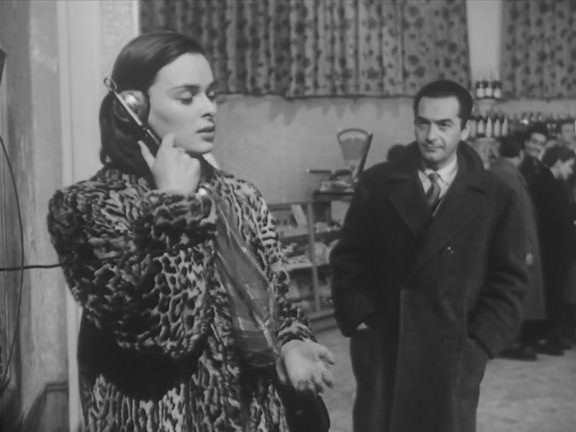
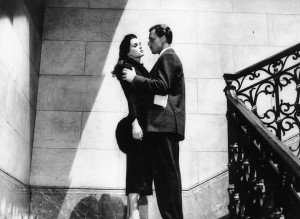
Signora Senza Camelie, La
(The Lady Without Camelias)
Italy, 1953 Director: Michelangelo Antonioni
If it lacks the final fusion of purposes characterizing a masterwork, La Signora Senza Camelie is nevertheless so unmistakably and remarkably the work of a master that one is shocked to discover the rather cursory critical treatment is has generally been accorded. A frequent bone of contention is Lucia Bosè’s performance as the starlet in search of an identity –- recalling that the part was first offered, in turn, to Gina Lollobrigida and Sophia Loren, and usually implying some difficulty in accepting Bosè as a persuasive Milanese-shopgirl-turned-sex-symbol. Yet what strikes one at once today is how totally her cold, somewhat remote beauty establishes and “places” the tone of the film, clarifying her cosmic distance from the brassy world of popular filmmaking as well as the natural way in which she might become the goddess of such a realm. In anticipation of Godard’s Vivre sa vie, Antonioni brilliantly opens the film with an image of Clara seen from behind, as an anonymous pedestrian -– tracing her fingers across a move poster and then strolling down the street, the camera gliding slowly after her until she turns into the cinema entrance. Read more
Written for Criterion’s Current (web site), April 21, 2009. — J.R.
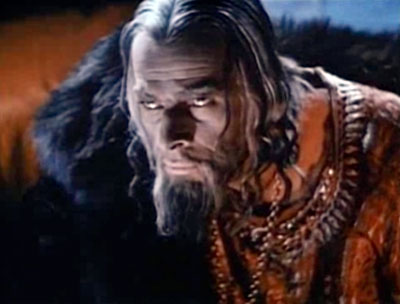
I recently had occasion to show Ivan the Terrible in a course on forties world cinema I’m teaching at Chicago’s School of the Art Institute, and found it more mind-boggling than ever. This has always been the Eisenstein feature that’s given me the most pleasure — the greatest Flash Gordon serial ever made as well as a showcase for the Russian master’s boldest graphics. But ever since I first saw it in the 1960s, this is a pleasure I’ve often had to apologize for, thanks to the vagaries and confusions of cold-war thinking. This thinking maintained that Eisenstein caved into Stalinist pressures, denounced the montage aesthetic that was central to his best work, and turned out an archaic, made-to-order glorification of a dictator.

Part of the problem has been reconciling the film’s multiple paradoxes — how much it functions as Eisenstein’s autocritique and apologia as well as an attack and glorification of Stalin, meanwhile combining elements of both high and low art at virtually every instant with its tortured angles and extreme melodrama. (Though portions of Part II could be termed inferior to Part I, the moment the film switches to color, using Agfa stock seized from the Germans during World War II, it moves into dizzying high gear, reminding us that Walt Disney was one of Eisenstein’s favorite filmmakers.) Read more
Written for The Unquiet American: Transgressive Comedies from the U.S., a catalogue/ collection put together to accompany a film series at the Austrian Filmmuseum and the Viennale in Autumn 2009. — J.R.
RHAPSODY RABBIT (1946)

Bugs Bunny, dripping with mannerisms associated with classical music and attempting to perform Liszt’s Second Hungarian Rhapsody at a concert, is interrupted or distracted by problems with his sheet music, coughs from the audience, a carrot break, and a mouse living inside the piano with both a taste for boogie-woogie and a determination to outclass the rabbit and featured performer. James Agee celebrated this 1946 animated short by Friz Freleng at some length, calling it “the funniest thing I have seen since the decline of sociological dancing”: “The best of it goes two ways: one, very observant parody of concert-pianistic affectations, elegantly thought out and synchronized; the other, brutality keyed into the spirit of the music to reach greater subtlety than I have ever seen brutality reach before.”
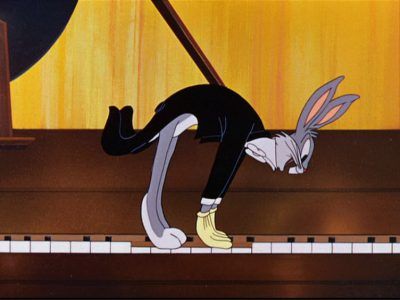
WHAT’S OPERA, DOC? (1957)
Eleven years after Rhapsody Rabbit, in 1957, the joint ingenuity of writer Michael Maltese and director Chuck Jones once again demonstrates how Americans can neither feel entirely comfortable with classical music and opera nor leave it alone, resulting here in a love-hate relationship to Richard Wagner’s Der Ring des Nibelungen featuring Bugs Bunny in drag, a golden-helmeted Elmer Fudd, snatches of ballet and Nuremberg lighting, outlandish sets that exceed any possibilities of stagecraft, and what may well be the strangest assortment of abstract shapes to be found anywhere in Jones’s work. Read more
Written for The Unquiet American: Transgressive Comedies from the
U.S., a catalogue/collection put together to accompany a film series at the
Austrian Filmmuseum and the Viennale in Autumn 2009. — J.R.


WIDE ANGLE SAXON (1976)
This comic short by Owen Land from 1976 could
conceivably be regarded as the Hellzapoppin of the
American experimental film. Just as Hellzapoppin
alludes to the then-contemporary Citizen Kane,
Wide Angle Saxon includes a parody of Hollis
Frampton’s 1971 (nostalgia), called Regrettable Redding
Condescension (alluding to Land’s own 1971 Remedial
Reading Comprehension), which is credited in
turn to one “Al Rutcurts” (i.e., the word «structural»
spelled backwards). But to complicate matters considerably
(if quite obscurely), Land (or George Landow,
as he was known at the time) converted to fundamentalist
Christianity shortly before making this film,
and we are told at the outset that this film’s nominal
hero, “Earl Greaves,” has recently had a religious
conversion as well.

ON THE MARRIAGE BROKER JOKE AS CITED BY SIGMUND FREUD IN WIT AND
ITS RELATION TO THE UNCONSCIOUS, OR CAN THE AVANT-GARDE ARTIST
BE WHOLED? (1979)
Owen Land continues his obscure blend of deconstructive slapstick and
various issues arising from his then-recent conversion to fundamentalist
Christianity in this puzzling if hilarious 17-minute short, during which
a “panderer” in one of the textual interpretations of the Marriage Broker
Joke becomes corrupted into “panda,” and then two men in panda suits
proceed to make a structural film about Japanese salted plums -– or
something like that. Read more
From the August 3, 2001 Chicago Reader. –J.R.
This month the Film Center is inaugurating a monthly “Music Movies” series, five programs that will play on Sundays and Thursdays. The focus in August is jazz films, and the programs include four classics I first saw years ago and four others I’ve just seen for the first time. The worst film in the bunch (Cannonball) happens to be the newest one, and the two most interesting (Cry of Jazz and Black and Tan) are the oldest, though I don’t see any particular trend in this.
It’s difficult to speak of any consistent evolution or devolution in jazz films, because each one is the product of a particular taste and sensibility. One rule I use when evaluating these films is how much we’re allowed to follow the music. Another rule, less obvious and more purist, is how important the on-screen listeners are — which matters a good deal, because jazz at its most exciting is a collective experience involving the audience as well as the interacting musicians. If the people on-screen aren’t seen listening when music is being played, we’re discouraged from listening intently.

This helps explain why I was driven batty by the new 23-minute video about Cannonball Adderley, a musician who has given me a lot of pleasure. Read more
Written for The Unquiet American: Transgressive Comedies from the U.S., a catalogue/ collection put together to accompany a film series at the Austrian Filmmuseum and the Viennale in Autumn 2009. — J.R.
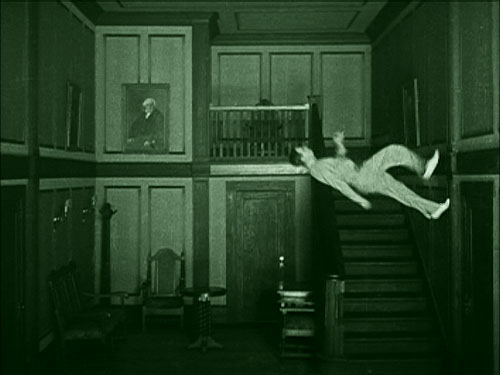
Nominally a rather silly satire about various fads in 1919 America ranging from Ouija boards and diverse superstitions to crackpot psychological experiments, this energetic Douglas Fairbanks comedy -– the first directorial effort of Victor Fleming, Fairbanks’s former cinematographer –- is chiefly a free-form adventure.
Like the projectionist’s dream in Keaton’s Sherlock, Jr., this is basically an occasion for the star’s athletic stunts and choreographic bursts of ardor and enthusiasm, as well as various playful breaches of the ordinary rules of space and time. Most of the latter occurs within an extended dream sequence that virtually opens the film -– set in motion by a sinister secret experiment being conducted by a mad scientist on the wealthy and brash hero, Daniel Boone Brown (Fairbanks) –- but the climactic rain storm and flood at the end, as the film shifts from New York to the countryside, seems almost equally dreamlike and arbitrary.
 Read more
Read more
Written for The Unquiet American: Transgressive Comedies from the U.S., a catalogue/ collection put together to accompany a film series at the Austrian Filmmuseum and the Viennale in Autumn 2009. — J.R.

I was slow to appreciate this masterpiece, which I now regard as Martin Scorsese’s best feature, and I credit Wim Wenders for convincing me that there was far more going on in this movie than I was initially prepared to see. Perhaps the key to this creepy fable about the American obsession with celebrity and media comes in the climactic comic monologue of Rupert Pupkin (Robert De Niro), brimming with self-hatred and shame about his family and his nondescript suburban/ethnic background, which in a way all of the preceding film prepares us for. The script by Paul D. Zimmerman, a onetime film critic at Newsweek, manages to be both non-specific and spot-on about everything that separates the haves from the have-nots -– a subject Scorsese seems to know like the back of his hand, and one made all the more complex by the fact that it’s often hard to separate the privileged from the deprived in this film (a fact spelled out by another troubling climax, the confrontation between Jerry Lewis and Sandra Bernhard). Read more

























